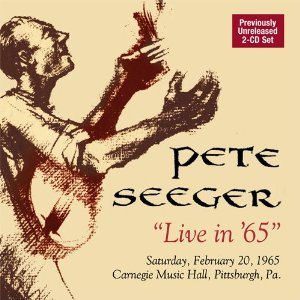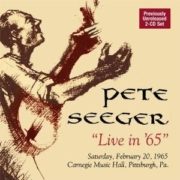PETE SEEGER – LIVE IN ââ¬Ë65
ARTIST: PETE SEEGER
TITLE: LIVE IN ‘65
LABEL: APPLESEED RECORDINGS
RELEASE: 2009
PETE SEEGER: HALF AS OLD, TWICE AS GOOD
 Having just ended a year that saw Pete Seeger’s 90th birthday celebrated by rock and folk royalty at the Madison Square Garden, after being awarded his first competitive Grammy for the album Pete Seeger: At 89, it is chastening to be reminded what all the fuss was about with this brand new release of an extraordinary concert that Pete gave 45 years ago on February 20, 1965-recorded live but only now released for the first time.
Having just ended a year that saw Pete Seeger’s 90th birthday celebrated by rock and folk royalty at the Madison Square Garden, after being awarded his first competitive Grammy for the album Pete Seeger: At 89, it is chastening to be reminded what all the fuss was about with this brand new release of an extraordinary concert that Pete gave 45 years ago on February 20, 1965-recorded live but only now released for the first time.
If you think you have heard the best of Pete Seeger with his Grammy-winning album, or even with the moving and memorable performance at Obama’s Inaugural Concert last January 20, think again.
But before you do, recall that they gave Paul Newman his first Oscar for The Color of Money, not The Hustler, they gave Einstein the Nobel Prize for his work on the electromagnetic field, not the Theory of Relativity, they gave Bob Dylan his Grammy for You Got to Serve Somebody, not Like a Rolling Stone, and they convicted O.J. Simpson for the theft of some sports memorabilia, not the murder of Nicole Simpson and Ron Goldman. In other words, by the time you get around to being recognized it is usually for a piece of crap, not your best (or in Simpson’s case, worst) work.
Napoleon Brandy may improve with age, but not performing artists. They seem to peak well before fifty, and it is mostly downhill from there.
If you want to hear Pete Seeger at his best, pick up this double album (two full CDs with thirty-one songs) all recorded at one incredible concert in the other Carnegie Hall, Carnegie Music Hall in Pittsburgh, Pennsylvania. In addition to being a great concert, it’s a wonderful history lesson, taught by a master musician-a people’s historian as true as Howard Zinn.
He starts right off by reminding the audience that Pittsburgh was the birthplace of America’s Troubadour-Stephen Collins Foster-who never set foot south of the Mason-Dixon Line so closely identified with his music. Pete plays Oh Susanna like the banjo was invented just for this song, with harmonies and counterpoint interwoven throughout.
It is no accident that Pete once arranged a Bach chorale for the banjo-his musical vocabulary is just as committed as Bach was to the idea of counterpoint. You may only notice it on the third or fourth listening, but Pete often sings the melody of a song while playing a harmony, and then later on livens up the arrangement even more by playing a counterpoint to the harmony. Chet Atkins was able to do this on the guitar, but he didn’t sing the song he was performing as Pete does.
Earl Scruggs then, and Bela Fleck now may be technically more accomplished on the banjo, but Pete was every bit as musically creative in the tapestry of sounds he would weave throughout a song that could be reduced to three chords-and a boring performance-in less gifted hands.
And yet at the same time Pete also valued simplicity as a musical virtue. He once introduced Old Joe Clark-included on the album-by saying that he learned to play it properly by listening to his brother Mike, and then asking him how he did it. “Why it’s nothing more than double-thumbing while you’re frailing,” replied Mike. Pete then charmingly added that he had written about that technique in his own banjo instruction book (How to Play the Five-String Banjo) but had never actually learned how to do it. So he “took his own advice-and practiced.” He then adds that when he first started playing the tune it had four chords in it; over time he reduced it to three-then two (G modulated to F)-and then finally simplified it to one.
This tension of a folk sensibility with a classical knowledge and ability is what makes Pete’s music so powerful-and it is not the only tension in his work. He sang for the working class, but was never of it; he sang for the Civil Rights Movementbut remained a white Yankee New Englander throughout; he sang against the War in Vietnam but did so with the credibility of a World War Two veteran who proudly put a Veterans of Foreign Wars sticker on his twelve-string guitar case; and he got labeled as an “un-American” for refusing to name names before the House Committee on Un-American Activities-this utterly American original who has devoted decades-through his Sloop Clearwater-to cleaning up his own backyard-for the Hudson River runs right by his log cabin in Beacon, New York.
Do I contradict myself? asked Walt Whitman. Very well-I contradict myself; I am large-I contain multitudes. Emerson put it more tendentiously: Foolish consistency is the hobgoblin of little minds. Pete speaks and sings in that great American tradition-a la modern poet William Carlos Williamshe has always gone against the grain even while documenting, preserving and significantly extending the treasury of American folk music.
On this magnificent recording, all derived from a single concert at Carnegie Music Hall in Pittsburgh-Pete ranges from traditional ballads to the hard-hitting protest songs he helped revive in the 1950s and 60s to the more gentle anthems he created out of earlier sources like Ecclesiastes (Turn, Turn, Turn) and the Russian novel And Quiet Flows the Don by Mikhail Sholokov (Where Have All the Flowers Gone).
But the most riveting performance of the album is an odd, chaotic moment when Pete reveals his own unique style of-I don’t know what else to call it-near madness as he starts to channel the Weavers by using the audience to make up for his missing former band-mates Lee Hays, Ronnie Gilbert and Fred Hellerman. He teaches them each part for This Little Light of Mine, and after demonstrating what they are supposed to be singing for the bass (Hays) the alto (Gilbert) and the baritone (Hellerman) he starts shifting back and forth to harmonize with the part he just passed on to them. If it weren’t done so effortlessly you would get a migraine listening to it, but instead you simply marvel at how uncannily he recreates a full quartet sound practically by himself.
It also clues you in (in case you hadn’t realized it) to the musical genius behind the most successful quartet in pop music history. Did I just say what I think I said? Oh yes, dear Reader; before they were blacklisted, the Weavers recording of Leadbelly’s theme song Goodnight Irene was number 1 on the Hit Parade for thirteen straight weeks in 1950-making it Life Magazine’s choice for the song of the half century and setting a record that was not equaled until the Bee Gees in the 1970s. Not the Beatles, not Elvis, and not Michael Jackson ever had a song stay at Number 1 for more than four months.
If you want to hear what Pete added to the mastery of the 12-string guitar he had learned from Leadbelly (and then passed on to others in a second instruction book, How to Play the 12-String Guitar Like Leadbelly), listen to his wonderful love song to language and different cultures All Mixed Up. While Leadbelly rarely left the bass strings to create his powerful runs (with the exception of Bourgeois Blues), Pete plays all over the neck to create an intellectual’s calypso classic, while evoking the many linguistic streams that converge into the great river of English. It’s a tour de force both instrumentally and lyrically.
Perhaps Leo Kottke is more of a virtuoso on the 12-String guitar, and perhaps Bela Fleck is more of a virtuoso on the 5-String banjo, but Pete extended the range of both, and it is hard to imagine either of these modern masters without Pete having paved the way.
Finally, Pete saves his classic children’s cante-fable Abiyoyo for the very end, telling and singing the story (which he created out of an African folktale fragment from a book his father Charles Seeger had given him) of a giant who is eventually tamed by a young boy who learns to play a tune that calms him down and puts him to sleep. Like the pied piper of the Grimm fairy tale, he saves the town from imminent danger with the power of music.
Pete has been inspiring, provoking and taming the savage beast of our baser instincts with a musical legacy unparalleled for its humanity and uncommon good sense for more than sixty years now. How fortunate we have been to be his audience and chorus. In an age when the word patriotism has been debased to mean shrill jingoism and intolerance for any views but one’s own, appreciate while you can this uniquely American voice of a true patriot who has embraced the world and given us all a better sense of who we can be.
Ross Altman has a Ph.D. in English. Before becoming a full-time folk singer he taught college English and Speech. He now sings around California for libraries, unions, schools, political groups and folk festivals. Ross Altman may be reached at greygoosemusic@aol.com













